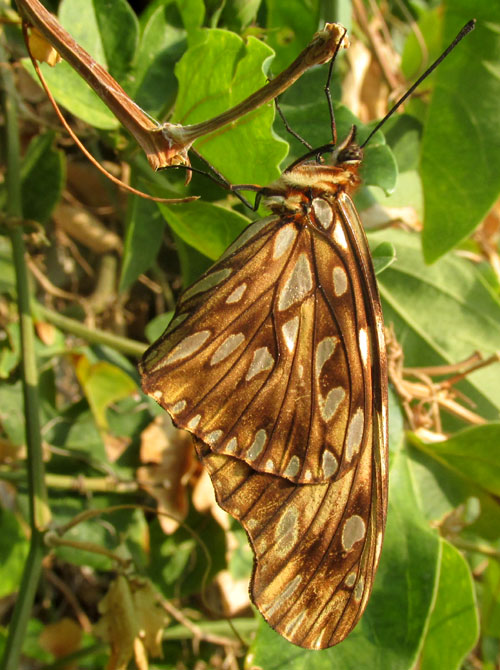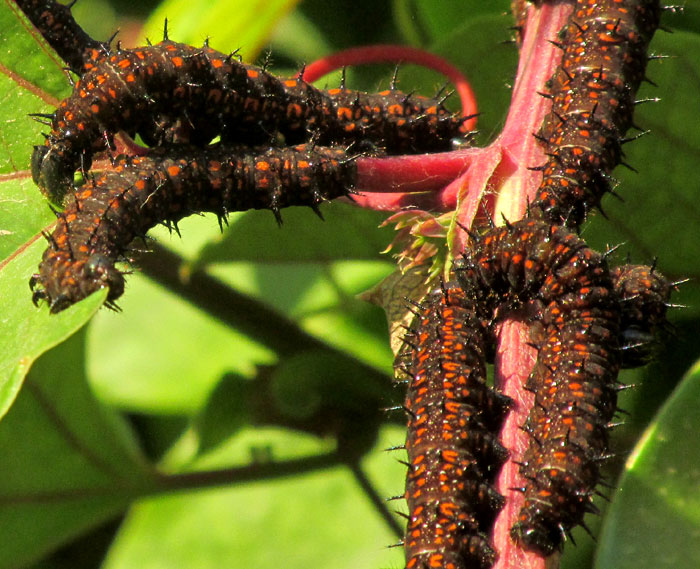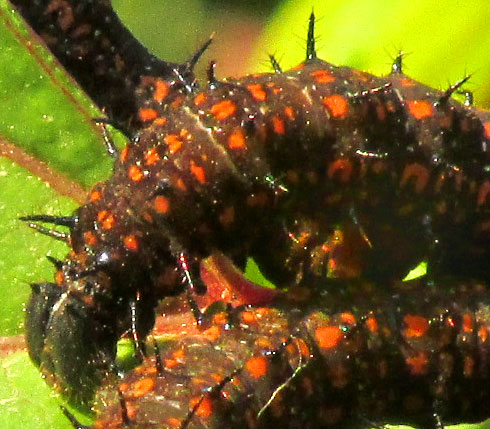Excerpts from Jim Conrad's
Naturalist Newsletter
entry dated April 12, 2023, issued from near Tequisquiapan, elevation about 1,900m (6200 ft), Querétaro state, MÉXICO
(~N20.55°, ~W99.89°)
JUNO SILVERSPOT BUTTERFLY RESTING

On March 25th, the caterpillars profiled below disappeared overnight. I hoped they'd formed chrysalises, and looked closely for them among the passionflower vine, though much of the vine was above my reach. On April 11, the above resting adult turned up in deep shade late one afternoon, unmoving even when the camera was brought close. The next morning, after a chilly night, it still hang there, still unmoving, even when touched by a finger. Later in the afternoon it was gone.
In the 2006 study done by Gricelda Méndez Martínez entitled "Ciclo Biológico de Dione juno huascuma Reakiirt, 1866," it took 15 to 20 days for adults to emerge from their chrysalises, so a good guess is that the adult appearing above had just emerged from its pupal stage, and was "resting" as its wings hardened.
The GBIF subspecies page for Dione juno currently lists three accepted subspecies, and ours is Dione juno subsp. huascama, occurring throughout Mexico except the northern arid lowlands, and Central America to Panama. Other subspecies are mainly or entirely South American.
While caterpillars of Dione juno appear to restrict themselves to feeding on the leaves of various taxa of passionflower vine, the adults take nectar from many flower types, in various plant families.
entry dated March 25, 2023, issued from near Tequisquiapan, elevation about 1,900m (6200 ft), Querétaro state, MÉXICO
(~N20.55°, ~W99.89°)
JUNO SILVERSPOT CATERPILLAR

Beneath an ornamental passionflower vine -- probably a hybrid producing prodigious flowers but seldom any fruits -- black pellets of caterpillar poop began showing up. Above you see some of the twenty or so of the closely packed caterpillars devouring passionflower leaves and dropping the pellets.

With the black, branched spines, at first I thought these were the larvae of some kind of fritillary butterfly, whose caterpillars eat passion vines, and on which we've seen such spines on caterpillars of the Gulf Fritillary. However, that species' caterpillars present very different colors and patterning.
Doing an image search on the keywords "oruga passiflora" -- oruga being Spanish for "caterpillar," and Passiflora being the genus of passionflower vines -- many pictures of caterpillars with black, branched spines turned up. They were larvae of the commonly occurring Bordered Patch butterfly, but their patterning didn't look exactly right. Also, the heads of those caterpillars weren't black and deeply longitudinally furrowed as seen above, with each head-half bearing a short, broad-based, needle-tipped spine.
Eventually such image searching on various keyword combinations led to a perfect match: Our caterpillars will metamorphose into chrysalis-type pupae, from which will emerge Juno Silverspot butterflies, DIONE JUNO.
Juno Silverspots are common from northern Mexico south through most of South America, as seen on the species' GBIF distribution map.
Juno Silverspot caterpillars love to eat passionflower leaves. A 2019 study by Moisés Arturo Menacé Amea and others entitled "Análisis en condiciones semicontroladas de la biología del gusano defoliador (Dione juno juno) de la maracuyá (Passiflora edulis), en el litoral del Ecuador", and using the English name Defoliation Worm, tells us Dione juno caterpillars are one of the most important pests during passion fruit cultivation on the Ecuadorian coast. Under semi-controlled conditions they found that Juno Silverspot caterpillars develop through five "instars," instars being phases between periods of molting during the development of the larvae of insects and other invertebrates.
Molting enables caterpillars to enlarge, since their "skins," or soft exoskeletons, are somewhat stiff. Molts are not considered stages of metamorphosis. Often each succeeding caterpillar instar is not only larger than the previous one, but also somewhat differently colored and patterned, which explains the varying appearances of a species' caterpillar pictures.
A 2020 study by Alonso Santos Murgas and others, entitled "Enemigos Naturales de Dione juno (Cramer, 1779) (Lepidoptera: Nymphalidae) en cultivo de Passiflora edulis Sims. J. (1818) Centro Regional Universitario de Cocle, Universidad de Panamá" found that the natural enemies of Juno Silverspot caterpillars are mainly ants, a kind of stinkbug and wasps, as well as parasites like tachinid flies. These enemies of the caterpillar significantly reduced destruction of passion-fruit crops, as well as, of course, causing a reduction in Juno Silverspot butterfly populations.